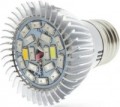Consumption
The power consumed by the light bulb during normal operation. The lower this indicator, the more economical the model and the cheaper it will cost to operate. In traditional incandescent lamps, the brightness of the glow also depended on the power, however, different types of lamps are presented on the modern market, with different efficiencies. Therefore, it is possible to uniquely link the power consumption and brightness only in lamps of the same type (see above), and to compare different types of models, you need to use the LON analogue (see below).
Luminous flux (brightness)
The conditional "amount of light" produced by a light bulb in normal mode. The higher the luminous flux, the brighter the light and the more clearly the illuminated scene will be visible. Note that lumen values are used primarily for special purposes; in everyday life, the estimation of brightness by the analogue of LON is more popular (see above), and here the ratio is as follows:
— 40 W analogue LON corresponds to a brightness of 370 lm;
— 60 W — 550 lm;
— 75 W — 800 lm;
— 100 W — 1200 lm;
— 150 W — 1900 lm;
— 200 W — 2700 lm.
Note that the principle "the more the better" in the case of the brightness of light bulbs is not always applicable. And the point here is not only energy consumption: too bright light is harmful to the eyes, leads to rapid fatigue and psychological discomfort.

